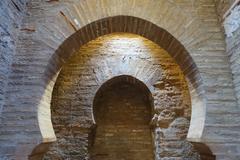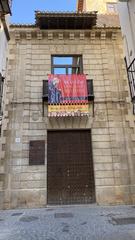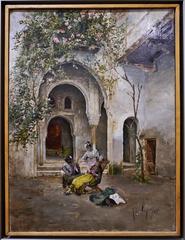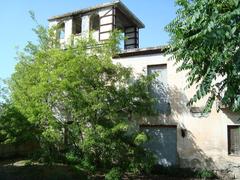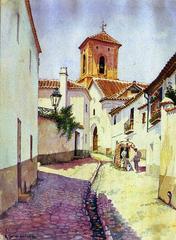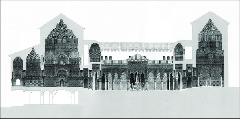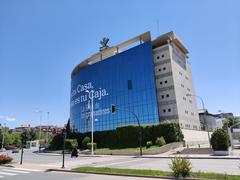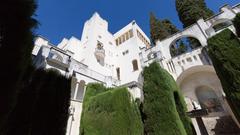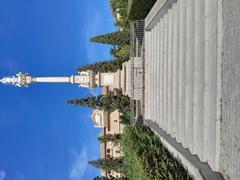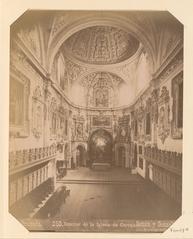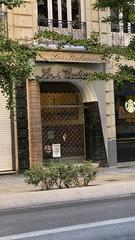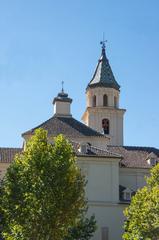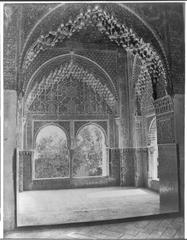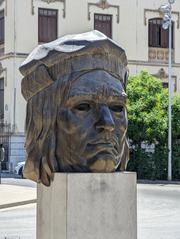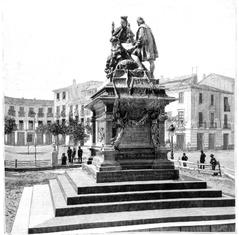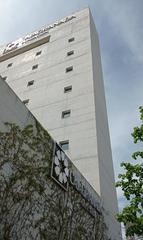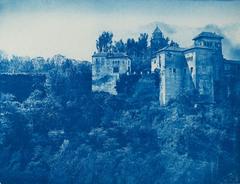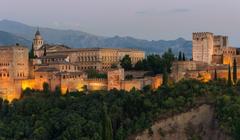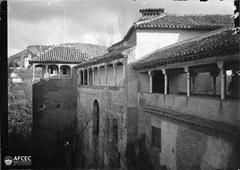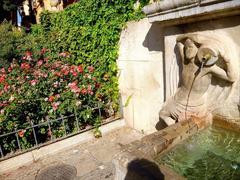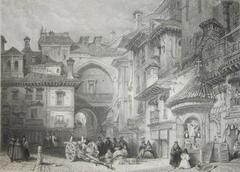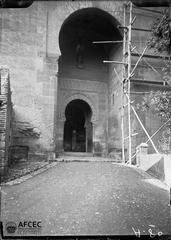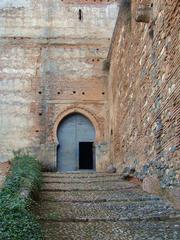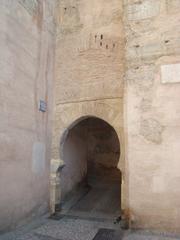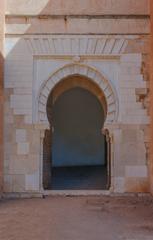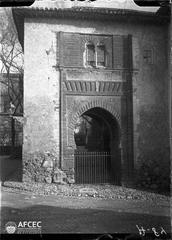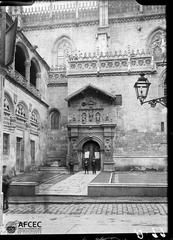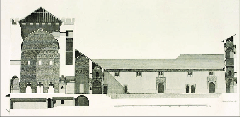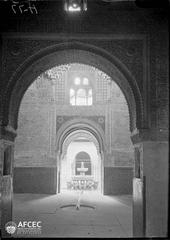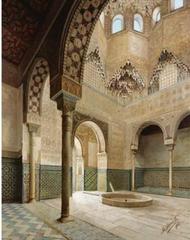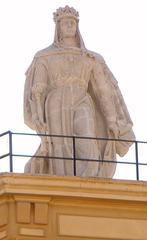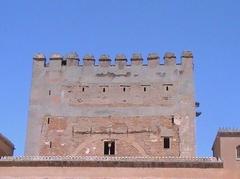
Visiting the Monasterio de San Jerónimo in Granada, Spain: Comprehensive Guide to History, Tickets, Hours & Tips
Date: 04/07/2025
Introduction
The Monasterio de San Jerónimo in Granada stands as one of Spain’s most significant Renaissance monuments, offering a spellbinding blend of architectural grandeur, religious heritage, and artistic splendor. Founded in the wake of the Christian conquest of Granada, the monastery is a testament to the city’s transformation and the ambitions of the Catholic Monarchs. This guide provides everything you need to plan your visit: historical context, architectural highlights, ticketing and hours, accessibility, nearby attractions, and essential travel tips (granadainfo.com, ticketsgranadacristiana.com, mappingspain.com).
Historical Overview
Foundation and Patronage
Established shortly after Granada’s conquest in 1492 by the Catholic Monarchs, Ferdinand II of Aragon and Isabella I of Castile, the Monasterio de San Jerónimo was both a spiritual center and a political symbol of Christian authority. The Hieronymite order, known for its intellectual and contemplative traditions, was selected to inhabit the monastery, reinforcing the monarchs’ vision of a religious and scholarly institution. Royal patronage, including substantial land and funding, laid the foundation for this ambitious project, which began in 1504 on the site of a former Nasrid palace (granadainfo.com).
A pivotal figure in its legacy was Gonzalo Fernández de Córdoba, the “Gran Capitán,” whose military prowess and close ties to the Catholic Monarchs cemented the monastery’s status. His decision to be buried here, alongside his wife, made the site a focal point for both religious and national remembrance (ticketsgranadacristiana.com).
Architectural Significance
The Monasterio de San Jerónimo is celebrated as one of Spain’s earliest and finest Renaissance buildings. Its construction, which spanned from 1504 to the mid-16th century, involved leading architects Jacopo Torni (Jacobo Florentino) and later Diego de Siloé, who introduced classical symmetry, proportion, and Italianate motifs into the design (en.granada.info, exclusivegranada.com).
Key Features:
- Cloisters: Two main cloisters, the primary one with arcaded galleries and orange trees, were designed for contemplation and daily monastic life. The second cloister, once reserved for the monastic community, is especially notable for having housed Empress Isabella of Portugal during her wedding to Charles I (andalucia.com).
- Church and Dome: The church’s imposing dome, completed between 1519 and 1547, exemplifies Renaissance innovation in space and light, offering vertical grandeur to the interior.
- Façade: Marked by a Doric doorway and classical columns, the façade reflects the transition from Gothic to Renaissance aesthetics.
Artistic and Cultural Legacy
The artistic heart of the monastery lies in its main altarpiece, a polychrome masterpiece by Pablo de Rojas, completed in the late 16th century. Gilded and intricately carved, it features scenes from the life of the Gran Capitán and serves as a prime example of Spanish Renaissance sculpture (everybodyhatesatourist.net).
Frescoes, paintings, and sculptural details by artists such as Diego de Siloé, Alonso Cano, and Juan Bautista Vázquez the Younger enrich the interiors, while the funerary art of the Gran Capitán’s tomb merges martial and religious imagery (holidify.com, en.granada.info).
Historical Transformations and Restoration
The monastery weathered periods of decline, notably during the Napoleonic invasion and the 19th-century Ecclesiastical Confiscations, which led to secularization and the expulsion of monks. Restoration efforts throughout the 20th century restored much of its former glory, and today it stands as a Bien de Interés Cultural, with part of the complex still inhabited by Hieronymite monks (mappingspain.com).
Practical Visitor Information
Location and Access
- Address: Calle Rector López Argüeta, 9, 18001 Granada
- Getting There: A 15-minute walk from Granada Cathedral; accessible by city buses (lines C1 and C3); taxis and public parking (e.g., Parking San Agustín) available (ticketsgranadacristiana.com).
Visiting Hours (as of 2025)
- Summer (April–September):
- Monday–Saturday: 10:00–13:00, 16:00–19:00 (doors close at 13:30 and 19:30)
- Sundays and holidays: 11:00–13:00, 16:00–19:00 (doors close at 13:30 and 19:30)
- Winter (October–March):
- Monday–Saturday: 10:00–13:00, 15:00–18:00 (doors close at 13:30 and 18:30)
- Sundays: 11:00–13:00, 15:00–18:00 (doors close at 13:30 and 18:30)
- Closed: Good Friday and select holidays. Always verify on the official website before your visit.
Ticket Prices
- General Admission: €5–€8
- Discounts: Available for students, seniors, groups
- Children under 12: Free or reduced price
- Combo Tickets: The “5 Monuments Combo” includes other Christian monuments in Granada at a discounted rate
- Purchase: Online booking recommended (official ticketing portal); tickets also available on-site
Guided Tours & Audio Guides
- Guided Tours: Offered in Spanish and English. Booking is recommended for an in-depth experience.
- Audio Guides: Available in multiple languages.
Accessibility
- Wheelchair Access: Main entrance and some ground floor areas are accessible. Upper floors and certain historic sections have steps and may not be accessible.
- Assistance: Contact the monastery in advance for specific needs at +34 958 22 03 92 or [email protected]
Visitor Facilities
- Restrooms: Near the entrance
- Cloakroom/Luggage: Not available; use city services
- Photography: Permitted without flash or tripods; discretion is advised in sacred areas
Highlights: What to See
- The Compass: Entrance courtyard with ornate façade by Diego de Siloé
- Main Cloister: Arcaded galleries and orange trees, a tranquil reflection space
- Church: Striking dome and Renaissance main chapel, home to the Gran Capitán’s tomb and Mannerist altarpiece
- Sacristy: Features the “Child Jesus of the Battles”
- Processional Cloister: Gothic-style with private views of the Empress Cloister
Special Events & Visitor Etiquette
- Events: The monastery hosts cultural events, concerts, and exhibitions; check the official website for schedules
- Etiquette: Maintain silence, dress modestly, and respect restricted areas
Nearby Attractions
- Granada Cathedral
- Royal Chapel of Granada
- Alhambra Palace
- Albaicín neighborhood
These sites are easily combined with your monastery visit, especially using the “5 Monuments Combo” ticket.
Frequently Asked Questions (FAQ)
Q: What are the Monasterio de San Jerónimo opening hours?
A: Varies seasonally; see above or check the official website for updates.
Q: How much are tickets and where can I buy them?
A: €5–€8 for adults; discounts available. Purchase online or on-site.
Q: Is the monastery accessible for people with disabilities?
A: Partially accessible. Contact in advance for details.
Q: Are guided tours available?
A: Yes, in Spanish and English; booking recommended.
Q: Is photography allowed?
A: Yes, without flash or tripods.
Summary & Travel Recommendations
The Monasterio de San Jerónimo is a must-see for visitors to Granada, offering a window into the city’s Renaissance history, artistic achievement, and spiritual life. With detailed visitor information, guided tours, and proximity to other top attractions, the monastery can be experienced with ease and depth. For the best experience, plan ahead—book tickets online, check seasonal opening hours, and consider guided tours. Leverage the Audiala app for audio guides and timely updates to enhance your visit.
Sources and Further Reading
- granadainfo.com
- ticketsgranadacristiana.com - Foundation of Monastery
- realmonasteriosanjeronimogranada.com
- ticketsgranadacristiana.com - History of Monastery
- mappingspain.com
- exclusivegranada.com
- andalucia.com
- en.granada.info
- everybodyhatesatourist.net
- holidify.com
- travelbestieug.com
- wikipedia.org










